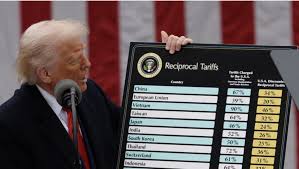The United States has unveiled a sweeping new tariff regime affecting 185 countries, including 51 African nations, with rates ranging from 10% to 50% depending on each country’s existing duties on American imports. Set to take effect April 5-9, these “reciprocal tariffs” represent President Donald Trump’s latest effort to address what he termed in an April 2 White House address an “urgent national security threat” posed by America’s $918 billion trade deficit.
South Africa faces the harshest impact among major African economies with a 30% tariff that effectively terminates its benefits under the African Growth and Opportunity Act (AGOA). As Africa’s largest AGOA beneficiary with $3.6 billion in duty-free exports to the U.S. in 2023, South Africa’s automotive sector—which accounts for 125,000 jobs linked to U.S. exports—stands particularly vulnerable. President Cyril Ramaphosa has already called for urgent bilateral trade negotiations, describing the tariffs as “punitive barriers to trade.”
Algeria also faces significant disruption with a 30% tariff on its $2.5 billion in exports to the U.S., primarily petroleum products. This new rate will likely reduce the competitiveness of Algerian hydrocarbons compared to those from Nigeria (14% tariff) and Gulf states (10%), potentially altering export patterns for a country that derives 95% of its export revenue from oil and gas.
Other heavily taxed African nations include Lesotho (50%), Madagascar (47%), and Mauritius (40%), while 26 African countries—including Morocco, Egypt, and Ethiopia—received the minimum 10% rate.
The tariffs effectively end AGOA, which since 2000 has allowed qualified Sub-Saharan countries duty-free access to U.S. markets for over 1,800 products. In 2023, the region exported $29.3 billion in goods to the United States, led by South Africa ($14 billion), Nigeria ($5.7 billion), and Ghana ($1.7 billion)
